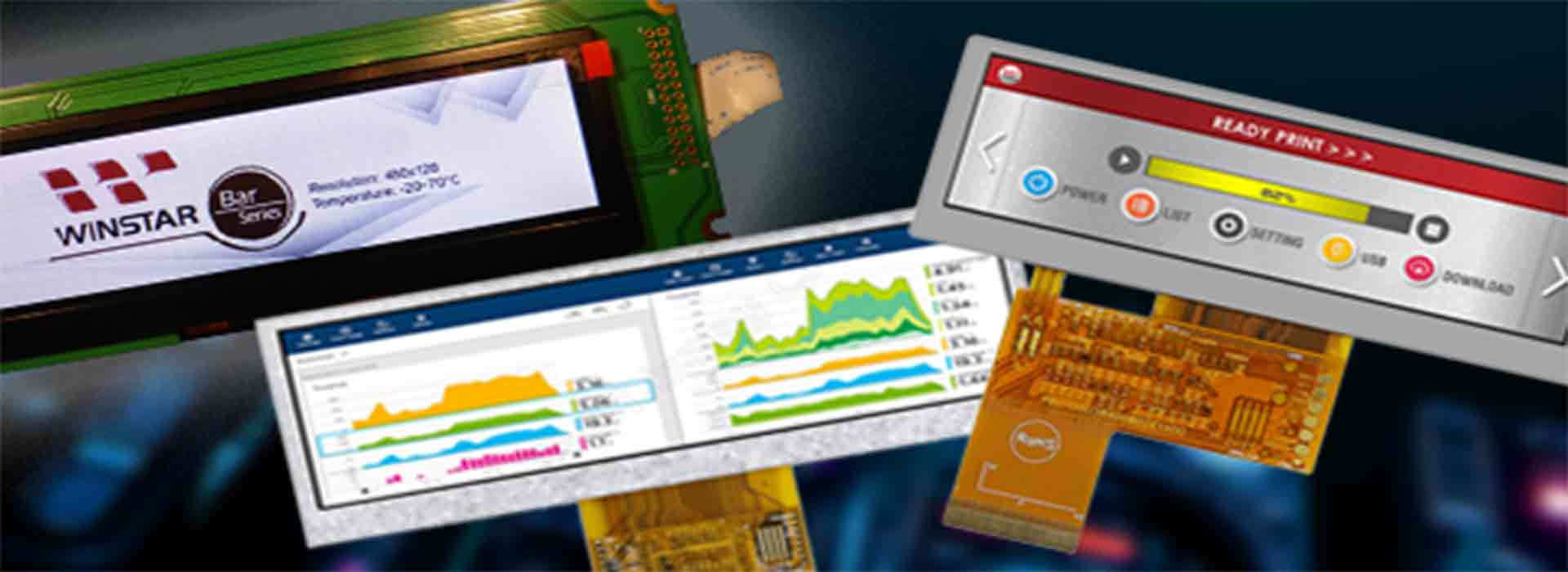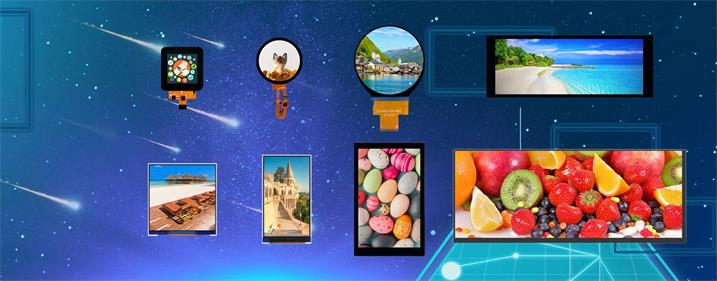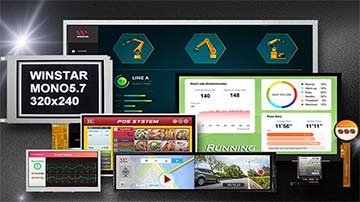Industrial grade TFT LCD modules (also known as TFT display modules, TFT displays, or TFT display panels) are widely used in various industrial environments due to their superior performance and durability. This article will provide a detailed introduction to the features, advantages, and applications of these modules, helping you choose the most suitable industrial-grade TFT display solution for your needs.
What is an Industrial Grade TFT LCD Module?
An industrial grade TFT LCD module is a high-performance digital display device commonly installed in industrial equipment and environments. These modules use high-brightness LED backlighting and advanced thin-film transistor technology, with each pixel controlled by an independent transistor, achieving high contrast and fast response times. TFT display modules can provide clear display effects under various lighting conditions and are suitable for multiple applications such as industrial automation, medical devices, outdoor displays, and transportation. TFT displays and TFT display panels are preferred display solutions in these fields due to their superior performance and durability.
Common Applications and Uses of TFT Display Modules
Industrial grade TFT display modules are widely used in several areas:
· Industrial Automation: TFT LCD modules are used for control panels and monitoring systems, providing real-time data and operational feedback. The high-resolution displays in industrial control panels and monitoring systems ensure precise and reliable operations.
· Medical Devices: TFT display modules are used to show medical data and images, ensuring high precision and reliability. The high-definition displays in medical instruments and medical devices enable doctors and nurses to read data more accurately.
· Outdoor Displays: TFT displays are used for billboards and information screens, capable of operating under various weather conditions. The high brightness and high contrast of outdoor advertising screens and information displays ensure clear visibility even under direct sunlight.
· Transportation: TFT display panels are used for in-vehicle displays and navigation systems, providing clear route and information displays. The high resolution and high brightness of in-vehicle display systems and traffic navigation systems ensure driver safety and convenience.
Considerations for Choosing an Industrial Grade TFT LCD Module
Choosing the right industrial grade TFT LCD module is crucial for ensuring the performance and reliability of your equipment. Here are some important factors to consider:
Application Scenario
· Environmental Conditions: Consider factors such as operating temperature range, humidity, lighting, vibration, and impact. Choose modules that can adapt to harsh environments, such as wide-temperature-range TFT display modules or vibration-resistant TFT displays.
· Display Content: Select the appropriate resolution and size based on the content to be displayed. For example, text displays can use lower resolutions, while graphic or video displays require higher resolution TFT display panels.
· Interface Type: Choose the appropriate interface type based on the controller, such as SPI, I2C, RS232, RGB, MIPI, etc.
Performance Parameters
· Resolution: Higher resolution ensures clearer display effects. High resolution provides rich image details and is suitable for scenes requiring fine displays.
· Brightness: Higher brightness ensures better visibility. High brightness is particularly useful for outdoor applications.
· Contrast: Higher contrast enhances image depth. High contrast makes images more vivid and suitable for applications requiring high visual effects.
· Response Time: Shorter response time ensures smoother image transitions. Fast response time is essential for dynamic image clarity, such as video playback.
· Viewing Angle: Wider viewing angles ensure better image quality from different angles. Wide-angle technology ensures clear images when viewed from various positions, suitable for multi-viewer applications.
Durability
· Materials: Choose modules made of robust materials (such as aluminum alloy or stainless steel) to improve durability and protection. High-quality materials ensure long-term stability, especially in industrial environments.
· Protection Rating: Choose modules with higher protection ratings to prevent dust and water ingress. High protection ratings ensure reliable operation in harsh environments, suitable for outdoor and industrial applications.
Other Factors
· Price: Choose modules within your budget. Balancing price and performance is key to maximizing return on investment.
· Supply Cycle: Choose suppliers with stable supply cycles to ensure timely delivery. Stable supply cycles help ensure project progress and avoid delays.
· After-sales Service: Choose suppliers that offer good after-sales service for timely support in case of issues. Quality after-sales service reduces user concerns and ensures long-term cooperation.
Essential Features and Capabilities of TFT Displays
Industrial grade TFT displays have the following key characteristics:
· High Resolution and Brightness: Ensure clear display effects under various lighting conditions. High resolution and high brightness provide rich image details and clear visibility in bright light.
· Wide Viewing Angle Technology: Ensure consistent image quality from different angles. Wide-angle technology ensures clear images when viewed from various positions.
· Durability and Reliability: Designed for extreme environments, they operate over a wide temperature range (typically from -30°C to 80°C) and can withstand vibration and impact. High durability and stability ensure long-term reliable operation in harsh environments.
· Low Power Consumption and Long Life: Equipped with LED backlighting, they have low power consumption and long life, reducing maintenance costs. Low energy consumption and long lifespan make them an eco-friendly and economical choice.
· Remote Management: Support remote content updates and management for easy maintenance. Remote control functions allow users to manage and update display content easily without on-site operations.
Technological Advancements and Future Directions for TFT Displays
With continuous technological advancements, industrial grade TFT displays will continue to evolve towards higher resolution, lower power consumption, and broader applications. New materials and processes will further enhance their performance and reliability. For example, the application of low-temperature polycrystalline silicon (LTPS) and oxide thin-film transistor (Oxide TFT) technologies will result in higher electron mobility and lower power consumption.
Consulting Professionals for TFT Display Equipment
If you are unsure how to choose the right module, consult professional display technology suppliers. They can recommend suitable modules based on your specific needs and provide technical support and after-sales service. For example, you can visit www.blhlcd.com for more information.
Common Test Reports and Certifications for TFT Display Panels
Industrial grade TFT display panels undergo various tests to ensure their performance and reliability. Here are some common test reports and certifications:
Environmental Tests
· Temperature Test: Test the module's performance at different temperatures to ensure it operates correctly under extreme conditions.
· Humidity Test: Test the module's performance at different humidity levels to ensure it can resist moisture.
· Lighting Test: Test the module's performance under different lighting conditions to ensure clear visibility in both bright and dark environments.
· Vibration Test: Test the module's performance under different vibration conditions to ensure it can withstand vibration.
· Impact Test: Test the module's performance under different impact conditions to ensure it can withstand impact.
Display Performance Tests
· Brightness Test: Test the module's brightness to ensure it meets application requirements.
· Contrast Test: Test the module's contrast to ensure it provides clear images.
· Response Time Test: Test the module's response time to ensure smooth image transitions.
· Viewing Angle Test: Test the module's viewing angle to ensure clear images from different angles.
Reliability Tests
· Lifespan Test: Test the module's lifespan to ensure it can operate stably over a long period.
· Durability Test: Test the module's durability to ensure it can withstand long-term use.
· Environmental Adaptability Test: Test the module's environmental adaptability to ensure it can operate under various conditions.
Certifications
· CE Certification: European Union safety certification ensuring the module meets EU safety and health standards.
· FCC Certification: Federal Communications Commission certification ensuring the module meets US electromagnetic compatibility standards.
· ROHS Certification: European Union Restriction of Hazardous Substances Directive certification ensuring the module does not contain harmful substances.
· IP Protection Rating: Indicates the module's protection rating, such as IP65 or IP67.
Obtaining Test Reports and Certification Information for TFT Display Modules
You can obtain test reports and certification information for industrial grade TFT display modules through the following methods:
· Contact the Supplier: Suppliers typically provide relevant test reports and certification information.
· Visit the Supplier's Website: Many suppliers publish related test reports and certification information on their websites.
· Consult Professionals: If you are unsure how to obtain test reports and certification information, consult professional display technology suppliers.
Installation Steps for TFT Display Components
When installing industrial grade TFT display components, follow these steps to ensure safe and correct installation:
1. Read the Manual: Carefully read the module's manual to understand the installation method and precautions.
2. Prepare Tools: Prepare the necessary tools, such as screwdrivers and wrenches.
3. Power Off: Ensure the device is powered off during installation to ensure safety.
4. Secure the Module: Mount the module securely on the device to ensure it is firmly in place.
5. Connect Interfaces: Connect the module's interfaces to the controller's interfaces to ensure proper connections.
6. Check Connections: Inspect all connections to ensure they are secure and there are no loose or short circuits.
7. Power On and Test: Power on the module and test its functionality to ensure it displays correctly.
Maintenance Recommendations for TFT Display Units
To ensure the long-term stable operation of industrial grade TFT display units, follow these maintenance measures:
· Regular Cleaning: Clean the module surface regularly to remove dust and dirt. Keeping the module surface clean improves display quality.
· Avoid Moisture: Prevent the module from getting wet to avoid damaging internal circuits. Maintaining a dry environment extends the module's lifespan.
· Avoid High Temperatures: Avoid exposing the module to high temperatures to prevent damage or shortened lifespan. Proper cooling measures improve module stability.
· Avoid Strong Vibrations: Avoid strong vibrations to prevent damage or loose connections. Secure installation reduces vibration effects.
· Regular Inspection: Regularly inspect the module's connections and performance to ensure it operates correctly. Timely detection and resolution of issues prevent larger problems.
· Timely Replacement: Replace the module if it malfunctions to avoid affecting equipment operation. Having spare modules ensures continuous operation.
Precautions for Installing Industrial Grade TFT Display Modules
When installing industrial grade TFT display modules, pay attention to the following details to ensure safe and correct installation:
· Installation Environment: Ensure the installation environment is clean, free of dust, moisture, and corrosive gases. Check that the installation surface is flat and even to avoid affecting the module's fixation and display effect.
· Safe Operation: Ensure all tools and materials are ready to avoid searching for them during the process. Handle the module carefully to avoid excessive force or impacts that could damage it.
· Fixing and Support: Use appropriate fixing devices, such as screws, nuts, and brackets, to ensure the module is secure. Check that the fixing devices are firm to avoid loosening during operation.
· Interface Connection: Ensure correct interface connections, such as VGA, HDMI, DVI, LVDS, RGB, SPI, etc. Use appropriate cables and connectors to avoid using substandard or damaged ones.
· Power and Grounding: Ensure the power supply matches the module's specifications and is properly grounded to prevent static electricity. Check that the power cable and interface are intact before connecting.
· Debugging and Inspection: After installation, perform initial debugging to check the display effect. Confirm that all connections are correct to avoid short circuits or overload.
· Record and Documentation: Record important information during the installation process, such as module model, interface type, and connection method. Save the installation manual and technical documents for future reference.
· Training and Guidance: Ensure operators understand how to use and maintain the module correctly. Provide necessary training and guidance to ensure operators can independently perform daily maintenance.
Maintenance Cycle for TFT Display Systems
The maintenance cycle for industrial grade TFT display systems depends on various factors, including the usage environment, frequency of use, module specifications, and maintenance resources. Here are some general recommendations:
Environmental Factors
· Temperature and Humidity: If the module operates under extreme temperature or humidity conditions, more frequent maintenance may be required. Maintaining appropriate temperature and humidity extends the module's lifespan.
· Dust and Contaminants: In environments with high levels of dust or contaminants, more frequent cleaning may be necessary. Regular cleaning prevents dust accumulation that can affect display quality.
Usage Frequency
· High Usage Frequency: If the module is frequently used, more frequent inspections and cleanings are recommended. Regular inspections ensure the module remains in optimal condition.
· Low Usage Frequency: If the module is used infrequently, the maintenance cycle can be extended. However, regular inspections are still necessary to ensure the module operates correctly.
Module Specifications
· Durability: Some modules may have higher durability, allowing for longer maintenance intervals. Highly durable modules reduce the need for frequent maintenance.
· Protection Rating: Modules with higher protection ratings may require less maintenance. High protection ratings protect the module from external environmental influences.
Maintenance Resources
· Maintenance Skills: If your team has professional maintenance skills, the maintenance interval can be extended. Professional maintenance personnel can complete tasks more efficiently.
· Maintenance Costs: Balance maintenance costs and benefits to determine the maintenance cycle. A reasonable maintenance plan saves costs and improves equipment reliability.
General Maintenance Recommendations for TFT Display Systems
· Cleaning: Perform surface cleaning at least once a month to remove dust and dirt. Keeping the module surface clean improves display quality.
· Inspection: Conduct comprehensive inspections at least once a quarter, including connections, interfaces, and display effects. Regular inspections help detect potential issues promptly.
· Maintenance: Based on the specific usage and environment of the module, perform maintenance at least once a year, including internal cleaning, inspection, and possible hardware replacement. Regular maintenance ensures the module's long-term stable operation.
· Special Circumstances
Environmental Changes: If environmental conditions change significantly, such as temperature, humidity, or dust levels, adjust the maintenance cycle accordingly. Timely adjustments to the maintenance plan address environmental changes.
Display Issues: If the module experiences display issues, conduct immediate inspections and maintenance. Prompt handling of display issues prevents larger problems.
Fault Handling Steps for TFT Display Equipment
When TFT display equipment malfunctions, take appropriate steps to diagnose and resolve the issue. Here are general fault handling steps for TFT modules:
1. Initial Check
Confirm Power Connection: Check if the module is powered on. Ensure the power connection is secure, with no short circuits or open circuits.
Check for Moisture or Heat: If necessary, remove the module from the environment. Maintaining a dry and appropriate temperature prevents module damage.
2. Observe Display
Check Display Content: Look for stripes, flickering, or color deviations. Try adjusting brightness and contrast settings to see if it improves the display. Correct settings enhance display quality.
3. Check Interfaces and Connections
Inspect All Interface Connections: Ensure they are secure, with no loose or damaged connections. Try reinserting the interfaces to see if it restores the display. Correct connections prevent signal transmission issues.
4. Software Settings
Check Controller Software Settings: Including resolution and refresh rate. Try restoring default settings or reconfiguring. Correct software settings ensure the module operates correctly.
5. Hardware Inspection
Inspect Internal Circuitry: Check for damaged components or poor contact. Use a multimeter or oscilloscope to measure and diagnose faults. Professional hardware inspection identifies potential issues.
6. Seek Professional Help
If the Above Steps Do Not Resolve the Issue: Contact the module supplier or professional technicians for diagnosis and repair. Provide a detailed description of the fault and maintenance records to help professionals quickly identify the problem. Professional support can resolve issues faster.
7. Backup Data
During Fault Handling: Ensure important data is backed up to prevent data loss. Regular backups reduce the risk of data loss.
8. Avoid Improper Operations
Avoid Replacing or Disassembling the Module Without Understanding the Issue: To prevent further damage. Cautious operations avoid unnecessary losses.
9. Record and Report
Record Fault Symptoms and Handling Processes: For future reference or reporting to superiors. Detailed records help summarize experiences and improve maintenance plans.
Conclusion
By following the above steps, you can effectively handle faults in TFT display equipment and restore its normal operation. If you are unsure how to proceed, seek professional help. We hope this article helps you better understand and choose industrial grade TFT LCD modules, ensuring your equipment performs and remains reliable at its best.








